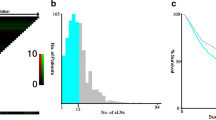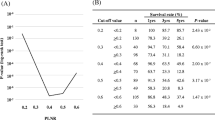Abstract
Purpose
The present study aims to validate possible stage migration of lymph node metastasis related to the insufficient examined lymph node (ELN) count in pN3a gastric cancer (GC) patients.
Methods
1976 pN3 patients who underwent the R0 surgery in three high-capacity institutions in China were enrolled to explore the stage migration of nodal involvement, and 3146 pN3 cases from the Surveillance, Epidemiology, and End Results (SEER) Program Registry were used as an external validation cohort.
Results
After the propensity score matching of the Chinese cohort, the ELN count, as an independent predictor for GC outcome, was confirmed to be associated with the stage migration of lymph node metastasis in pN3a patients based on the univariate and multivariate survival analyses. Logistic regress was adopted to elucidate that the ELN count was an independent factor related to the long-term survival status of GC patients after curative surgery. Likelihood ratio test showed that the ELN count had the smallest Bayesian information criterion value among the clinicopathologic variables, corresponding to an efficient model to predict outcomes. Subsequently, stage migration of lymph node metastasis was predominantly detected in pN3a patient sub-group with insufficient (less than 16) ELN count, who presented with similar prognosis as the pN3b patients (P = 0.463) as per the stratum analysis with Kaplan–Meier. These methods were further validated using data from the SEER cohort, and the similar promising results were obtained.
Conclusion
pN3a patients with insufficient ELN count should be considered as pN3b cases to achieve accurate prognostic evaluation after curative gastrectomy.





Similar content being viewed by others

Abbreviations
- 95% CI:
-
95% Confidence intervals
- ELN:
-
Insufficient examined lymph node
- GC:
-
Gastric cancer
- SEER:
-
Surveillance, Epidemiology, and End Results
- BIC:
-
Bayesian information criterion
- TNM:
-
Tumor–node–metastasis
- AJCC:
-
American Joint Commission for Cancer
- 5-YSR:
-
5-Year survival rate
- DLN:
-
Dissected lymph node
- TJMUCC:
-
Tianjin Medical University Cancer Institute and Hospital
- SYSUCC:
-
Sun Yat-sen University Cancer Center
- CMUFAH:
-
First Hospital of China Medical University
- EGJ:
-
Esophagogastric junction
- OS:
-
Overall survival
References
Brierley J, Gospodarowicz MK, Wittekind C (2017) TNM classification of malignant tumours. Wiley, New York
Coburn NG, Swallow CJ, Kiss A et al (2006) Significant regional variation in adequacy of lymph node assessment and survival in gastric cancer. Cancer 107:2143–2151
Deng J, Liang H, Sun D et al (2008) Prognosis of gastric cancer patients with negative node metastasis following curative resection. Outcomes of the survival and recurrence. Can J Gastroenterol 22:835–839
Deng JY, Liang H, Sun D et al (2009) Outcome in relation to numbers of nodes harvested in lymph node positive gastric cancer. Eur J Surg Oncol 35:814–819
Deng J, Zhang R, Pan Y et al (2014a) Comparison of the staging of regional lymph nodes using the sixth and seventh editions of the TNM classification system for the evaluation of overall survival in gastric cancer patients: findings of a case-control analysis involving a single institution in China. Surgery 156:64–74
Deng J, Liang H, Ying G et al (2014b) Clinical significance of the methylated cytosine-phosphate-guanine sites of protocadherin-10 promoter for evaluating the prognosis of gastric cancer. J Am Coll Surg 219:904–913
Deng J, Yamashita H, Seto Y et al (2017) Increasing the number of examined lymph nodes is prerequisite for improvement accurate evaluation the overall survival of node-negative gastric cancer patients. Ann Surg Oncol 24:745–753
Deng J, Liu J, Wang W et al (2018) Validation of clinical significance of examined lymph node count for accurate prognostic evaluation of gastric cancer for the eighth edition of the American Joint Committee on Cancer (AJCC) TNM staging system. Chin J Cancer Res 30:477–491
Feinstein AR, Sosin DM, Wells CK (1985) The Will Rogers phenomenon. Stage migration and new diagnostic techniques as a source of misleading statistics for survival in cancer. N Engl J Med 312:1604–1608
Hayashi S, Kanda M, Ito S et al (2019) Number of retrieved lymph nodes is an independent prognostic factor after total gastrectomy for patients with stage III gastric cancer: propensity score matching analysis of a multi-institution dataset. Gastric Cancer 22:853–863
In H, Solsky I, Palis B et al (2017) Validation of the 8th edition of the AJCC TNM staging system for gastric cancer using the national cancer database. Ann Surg Oncol 24:3683–3691
Jaehne J, Meyer HJ, Maschek H et al (1992) Lymphadenectomy in gastric adenocarcinoma: a prospective and prognostic study. Arch Surg 127:290–294
Jiao XG, Deng JY, Zhang RP et al (2014) Prognostic value of number of examined lymph nodes in patients with node-negative gastric cancer. World J Gastroenterol 20:3640–3648
Liu YY, Fang WL, Wang F et al (2017) Does a higher cutoff value of lymph node retrieval substantially improve survival in patients with advanced gastric cancer?—Time to embrace a new digit. Oncologist 22:97–106
Nakajima T (2002) Gastric cancer treatment guidelines in Japan. Gastric Cancer 5:1–5
Sano T, Coit DG, Kim HH et al (2017) Proposal of a new stage grouping of gastric cancer for TNM classification: International Gastric Cancer Association staging project. Gastric Cancer 20:217–225
Sobin L, Gospodarowicz M, Wittekind C (2009) TNM classification of malignant tumours, 7th edn. Wiley, New York
Acknowledgements
This study was supported in part by Grants from the Programs of National Natural Science Foundation of China (no. 81572372, no. 81172080, no. 81201773, no. 81572372), National Key Research and Development Program (MOST-2016YFC1303200), and National Precision Medicine Research Program (2017YFC0908300).
Author information
Authors and Affiliations
Contributions
JD studied the concept and design. JD, YD, YQ, WW, ZW, and Z S collected the data. JD, YD, and YQ analyzed and interpreted the data. JD, YD, and YQ drafted the manuscript. HL, ZZ, and HX critically revised the manuscript for important intellectual content. YD, YQ, and JD performed the statistical analysis.
Corresponding authors
Ethics declarations
Conflict of interest
All authors declare there is not conflict of interest in this manuscript.
Ethical approval
All procedures performed in studies involving human participants were in accordance with the ethical standards of the institutional research committee and with the 1964 Helsinki Declaration and its later amendments or comparable ethical standards.
Additional information
Publisher's Note
Springer Nature remains neutral with regard to jurisdictional claims in published maps and institutional affiliations.
Electronic supplementary material
Below is the link to the electronic supplementary material.

432_2019_3081_MOESM1_ESM.jpg
Suppl Fig 1. Scheme of included pN3 patients from the three high–capacity Chinese institutions (training cohort) (JPEG 1714 kb)


Rights and permissions
About this article
Cite this article
Dong, Y., Qiu, Y., Deng, J. et al. Insufficient examined lymph node count underestimates staging in pN3a patients after curative gastrectomy: a multicenter study with external validation. J Cancer Res Clin Oncol 146, 515–528 (2020). https://doi.org/10.1007/s00432-019-03081-0
Received:
Accepted:
Published:
Issue Date:
DOI: https://doi.org/10.1007/s00432-019-03081-0



